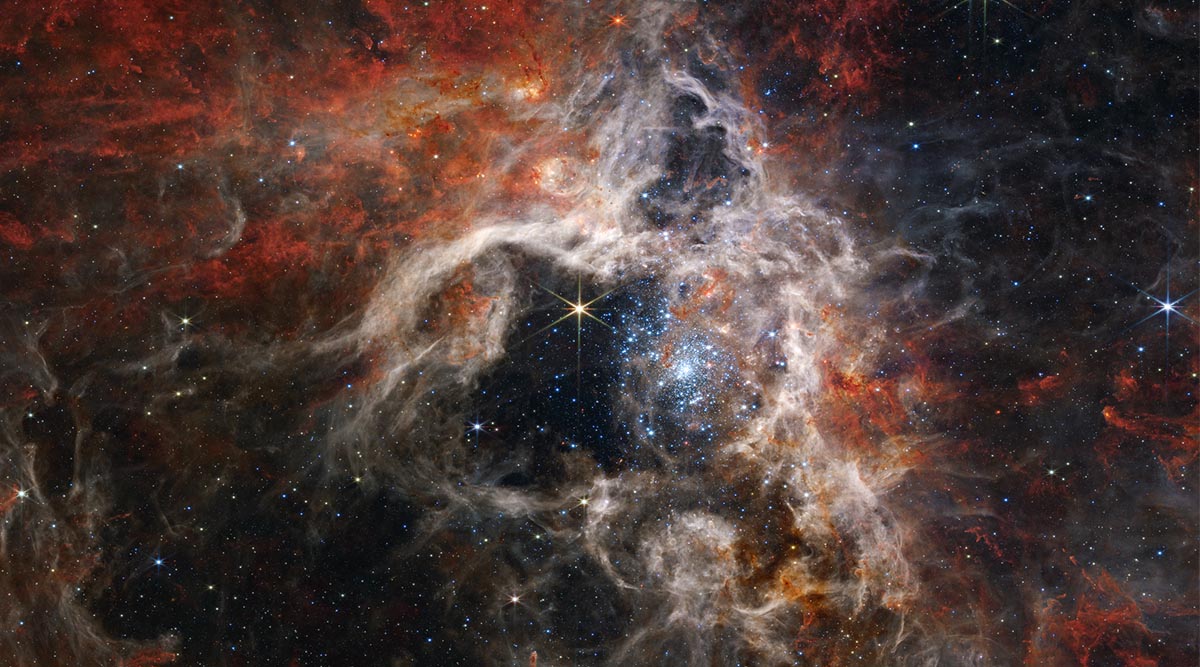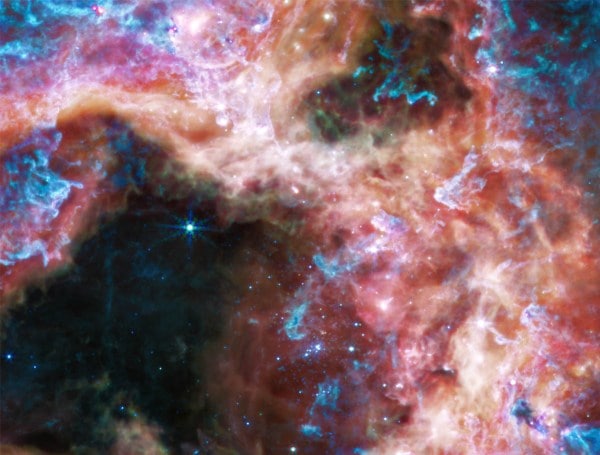 Image of the Tarantula Nebula captured by the James Webb Space Telescope's Near-Infrared Camera (NIRCam). (Image credit: NASA, ESA, CSA, STScI, Webb ERO Production Team
Image of the Tarantula Nebula captured by the James Webb Space Telescope's Near-Infrared Camera (NIRCam). (Image credit: NASA, ESA, CSA, STScI, Webb ERO Production TeamTarantula Nebula: The James Webb Space Telescope has captured this beautiful image of a nebula called 30 Doradus. It is also referred to as the Tarantula Nebula because of the dusty filaments that feature prominently in previous telescope images of the nebula.
This stellar nursery has been a favourite target of astronomers studying star formation and this image from Webb reveals it in exquisite detail. Apart from the distant background galaxies, Webb also captured the detailed structure and composition of the nebula’s gas and dust.
The Tarantula Nebula is almost 161,000 light-years away in the Large Magellanic Cloud galaxy and is one of the largest and brightest star-forming regions in the Local Group (Galaxies nearest to our own.) It also hosts some of the hottest and most massive stars we know. To find out more about the blisteringly hot birthplace of stars, astronomers focused three of Webb’s high-resolution infrared instruments on it.
This Webb caught a giant space tarantula! 🕸️ Take a moment to stare into thousands of never-before-seen young stars in the Tarantula Nebula. @NASAWebb reveals details of the structure and composition of the nebula, as well as background galaxies: https://t.co/DZePgDpPEH pic.twitter.com/aSmPDqgKTE
— NASA (@NASA) September 6, 2022
When viewed with the telescope’s Near-Infrared Camera (NIRCam) instrument, this region looks like a burrowing Tarantula spider’s home, lined with silk. The cavity at the centre of the nebula is hollowed out because of the intense radiation from a cluster of massive young stars, which can be seen sparkling in blue, in the image. The stars’ powerful stellar winds erode all but the densest surrounding areas of the nebulae, creating pillars that appear to point towards the cluster. These “pillars” contain forming protostars, which will eventually emerge and contribute to shaping the nebula.
 Image of the Tarantula Nebula captured by JWST’s MIRI. (Image credit: NASA, ESA, CSA, STScI, Webb ERO Production Team)
Image of the Tarantula Nebula captured by JWST’s MIRI. (Image credit: NASA, ESA, CSA, STScI, Webb ERO Production Team) The same region takes a completely different appearance when viewed in the longer infrared wavelengths detected by the Webb telescope’s Mid-Infrared Instrument (MIRI). In the image taken with MIRI, the hot stars fade as the cooler gas and dust seem to glow. Points of light within this image indicate embedded protostars that are still gaining mass. The dust grains in the nebula absorb or scatter the shorter wavelengths of light. But longer mid-infrared wavelengths penetrate the dust and reveal a completely different cosmic landscape.
Star formation in our universe was at its peak during a period called the “cosmic noon,” when the universe was only a few billion years old. The Tarantula Nebula has a similar chemical composition to the enormous star-forming regions observed during this cosmic noon, which is an important reason why astronomers are so interested in the nebula.
